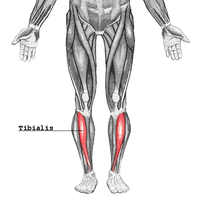
The interosseus crural nerve: an anatomical study of a rarely described structure.
Sign Up to like & getrecommendations! Published in 2022 at "Clinical anatomy"
DOI: 10.1002/ca.23897
Abstract: The interosseous crural nerve (IOCn) is said to arise distally from muscular branches of the tibial nerve innervating the deep muscles of the posterior compartment of the leg. Here, we present the results of a… read more here.
Keywords: nerve; crural nerve; anatomical study; iocn ... See more keywords

Medial approach to the peroneal vessels as recipients for free flap reconstruction of the leg
Sign Up to like & getrecommendations! Published in 2019 at "Microsurgery"
DOI: 10.1002/micr.30462
Abstract: The anatomic variation in the branching pattern of the popliteal vessel has been well‐established. Little has been written in the literature regarding recipient vessel selection for microvascular reconstruction in the lower extremity as it pertains… read more here.
Keywords: reconstruction; medial approach; anatomy; peroneal vessels ... See more keywords

[The conspicuous leg].
Sign Up to like & getrecommendations! Published in 2018 at "Der Internist"
DOI: 10.1007/s00108-018-0386-5
Abstract: Symptoms of the leg or of both legs, may indicate a need for evaluation and/or treatment, which must be clarified urgently or even as an emergency situation. Among the diseases which must be considered from… read more here.
Keywords: leg; conspicuous leg;

[Chronic lower leg pain: entrapment of common peroneal nerve or tibial nerve-German version].
Sign Up to like & getrecommendations! Published in 2019 at "Der Unfallchirurg"
DOI: 10.1007/s00113-019-0644-6
Abstract: Young individuals with chronic exercise-induced lower leg pain (ELP) who have normal compartmental muscle pressures and normal imaging occasionally suffer from a nerve entrapment syndrome. These patients have consistently undergone a variety of diagnostic tests and often… read more here.
Keywords: entrapment common; leg pain; lower leg; leg ... See more keywords

One-leg inactivity induces a reduction in mitochondrial oxidative capacity, intramyocellular lipid accumulation and reduced insulin signalling upon lipid infusion: a human study with unilateral limb suspension
Sign Up to like & getrecommendations! Published in 2020 at "Diabetologia"
DOI: 10.1007/s00125-020-05128-1
Abstract: Aims/hypothesis Physical inactivity, low mitochondrial function, increased intramyocellular lipid (IMCL) deposition and reduced insulin sensitivity are common denominators of chronic metabolic disorders, like obesity and type 2 diabetes. Yet, whether low mitochondrial function predisposes to… read more here.
Keywords: insulin; oxidative capacity; mitochondrial oxidative; leg ... See more keywords

1.7 cm elongated Achilles tendon did not alter walking gait kinematics 4.5 years after non-surgical treatment
Sign Up to like & getrecommendations! Published in 2022 at "Knee Surgery, Sports Traumatology, Arthroscopy"
DOI: 10.1007/s00167-022-06874-y
Abstract: The aim of the present study was to evaluate Achilles tendon length after non-surgical treatment of acute Achilles tendon rupture (aATR), and to evaluate indirect effects of possible persistent elongation on kinematics. The study was… read more here.
Keywords: achilles tendon; kinematics; treatment; peak pressure ... See more keywords

Neuromechanical control of leg length and orientation in children and adults during single-leg hopping
Sign Up to like & getrecommendations! Published in 2019 at "Experimental Brain Research"
DOI: 10.1007/s00221-019-05548-5
Abstract: Adult-like fine control of cyclical motor patterns found in locomotion develops into adolescence. Single-leg hopping in place is one such motor pattern where children have demonstrated a reduced capacity to control horizontal motion and match… read more here.
Keywords: orientation; control; segment; leg length ... See more keywords

Spring-like leg dynamics and neuromuscular strategies for hopping on a mini-trampoline in adults and children
Sign Up to like & getrecommendations! Published in 2020 at "Experimental Brain Research"
DOI: 10.1007/s00221-020-05873-0
Abstract: Improved balance control is an often-cited potential benefit for trampoline interventions. However, it is unknown whether the soft, elastic surface of a trampoline elicits different motion and neuromuscular strategies between adults and children. Therefore, the… read more here.
Keywords: hopping mini; trampoline; leg; mini trampoline ... See more keywords

Stance leg and surface stability modulate cortical activity during human single leg stance
Sign Up to like & getrecommendations! Published in 2021 at "Experimental Brain Research"
DOI: 10.1007/s00221-021-06035-6
Abstract: Mobile Electroencephalography (EEG) provides insights into cortical contributions to postural control. Although changes in theta (4–8 Hz) and alpha frequency power (8–12 Hz) were shown to reflect attentional and sensorimotor processing during balance tasks, information… read more here.
Keywords: surface stability; stance; leg; cortical activity ... See more keywords

The influence of short-term high-altitude acclimatization on cerebral and leg tissue oxygenation post-orthostasis.
Sign Up to like & getrecommendations! Published in 2021 at "European journal of applied physiology"
DOI: 10.1007/s00421-021-04765-7
Abstract: PURPOSE Orthostasis at sea level decreases brain tissue oxygenation and increases risk of syncope. High altitude reduces brain and peripheral muscle tissue oxygenation. This study determined the effect of short-term altitude acclimatization on cerebral and… read more here.
Keywords: orthostasis; tissue oxygenation; oxygenation; leg ... See more keywords

Painful leg and moving ankle syndrome
Sign Up to like & getrecommendations! Published in 2017 at "Neurological Sciences"
DOI: 10.1007/s10072-017-2940-7
Abstract: Dear Editor Painful leg and moving toe syndrome is characterized by pain in the feet or lower limbs and spontaneous movement of the toes [1]. The variants of this syndrome include phenotypes affecting the upper… read more here.
Keywords: movement; pain; ankle movements; leg ... See more keywords